By Clint Harlan
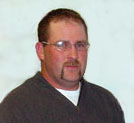 Missouri
Missouri
Just a quick account of the most recent success of my personal Wavewalk 500 kayak –
In January 2012 I had a goal to shed a few pounds and become a little more healthy for my family. In the past, setting a new year’s resolution didn’t work for long, as for many, so I stepped up the challenge for myself.
I came across the Missouri River 340 Mile (MR 340), which is the world’s longest non stop paddling race, paid the entry fee and set my goals in motion.
With seven months to plan and train I started the search to find a boat that would not only allow me to complete the 340 miles, but do it in the 88 hour time requirement.
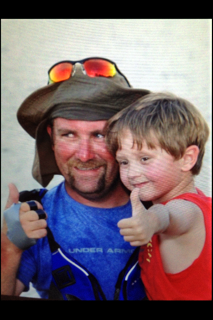
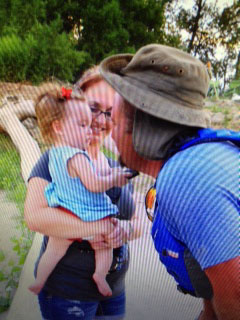
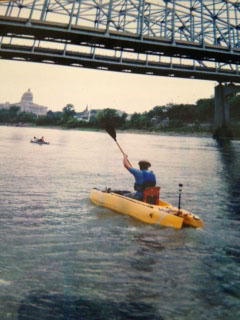 I was going unsupported traveling with the (spot) GPS tracking system which was required, so storage was important.
I was going unsupported traveling with the (spot) GPS tracking system which was required, so storage was important.
Seven checkpoints were staged along the race but I felt the less I stopped the better my time would be, and the longer I was on the river the longer I felt I would stay ashore if I was tired.
Comfort was my next main concern, since 88 hours in a kayak is a huge requirement for anyone. I felt that having the option to have so many different paddling positions available to me in my Wavewalk 500 kayak gave me a considerable advantage on my competitors, who were constrained to the L position. Moving from a sitting to a standing position and back allowed me to work through muscle cramps and body fatigue that many of the other racers were experiencing in their traditional racing kayak models. Keep in mind that by the half way point or around 170 miles we had lost 50% of the racers that had started the race for multiple reasons, including 5 that had to take the ambulance to the hospital, from what I heard. So to make it to the halfway point in my mind was a great feat in itself.
By this time the exhaustion was setting in, lack of sleep and my mind playing tricks on me was a big wall for me to overcome.
Throughout this sleep deprivation of a run I felt very confident in my W500, for it is a very forgiving boat. In many of the slender racing kayaks that took part in the race, a simple missed stroke, or a sudden adjustment could have lead to someone falling out of the boat, or worse. I hate to admit it, but at one point in the race in the deep dark of the river I actually came upon a marker buoy at the wrong angle, and actually hit the buoy square between the hulls of my W kayak. Shaken up, I simply sat square in the center of the boat and let the current carry me away from the marker. Not a mark on the boat, and I dare say if it would have been any other boat it would have went under. My point is that the safety of this Wavewalk boat is unrivaled.
Knowing that prior to the race that I could have purchased any other kayak or canoe, I have no regrets about purchasing this W. Since the W500 is not a racing kayak, I made the race harder for myself than it needed to be. The traditional, very long and narrow racing kayak hull designs I could have chosen would have decreased my efforts by a lot. The W500 is much shorter, and was not designed for racing, and there were times during the race where I thought to myself – “What have I done?”. My strokes had to be harder, and my glide between strokes was shorter compared to the long and fast racing kayaks I competed against.
Head winds hurt, and I was grateful for the few tail winds I experienced. All in all, I think I had to put more effort into finishing this race than most participants did. Prior to the start, I was approached by more than one fellow racer, who told me there was no way I would finish…- “You can’t finish!” -“What are you thinking?!”…-“What kind of boat is that?!”… -“Where did you get that?!”…
Because my W500 was so much shorter than the other kayaks, some of my competitors dubbed it “Rubber Ducky”. Little did they know that proving them all wrong would add to my driving force.
It wasn’t fast, and it wasn’t easy, but I finished in 83 hours in my division. Taking out the D&F I placed 71 in the Men’s solo division, which is what I had initially registered under.
My goal was to be in the top 100 of the 412 that entered the race, and the W kayak got me to the finish line, and placed me right where I wanted to be.
To add a twist to the story, there was a stand up paddling division that I could have registered in, and of course there were not as many racers in this division, but as the roster stands as of today I placed 2nd in the stand up bracket, and not only did I receive my medal for the Men’s solo, I also got to bring home a second place trophy 😀
Needless to say my W kayak is decorated with awards, and it is just the first of many races I plan to be in.
My benefits beyond the race, and the main reason I chose to purchase the W kayak, is for my two great kids – Cole is 5 and Jade is right at 1 now. I not only finished the world’s longest nonstop kayak race in my W fishing kayak, but I now own the best recreational boat on the planet, in my opinion. All the other, ultra fast kayaks and canoes that took part in the race will sit until the next race. In contrast, I’ll hold within me memories of my great race, and visions of time spent with my children in our W kayak, catching fish and having a great time together, until the next race. So I compromised speed and glide in order to gain comfort, safety and durability – To each their own, but I just wanted to let you know that the W is proven in many ways, I wanted to add long distance and endurance paddling to it.
Thank you Wavewalk
Your sore-hand paddler,
Clint Harlan
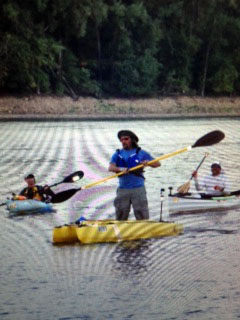
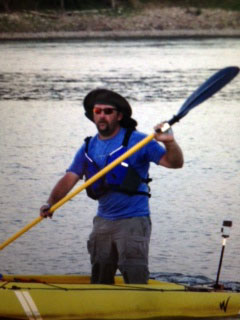
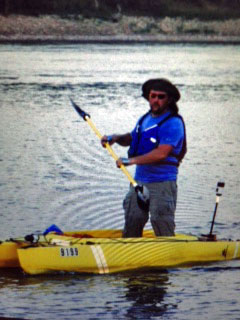


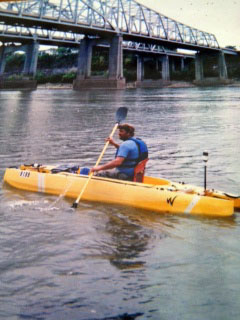
Thanks Clint,
This is awesome!
When Clint first told me about his plan to get a W500 and use it in a 340 mile long endurance paddling race, I responded: “The W500 is faster than most fishing kayaks, but it’s not as fast as a racing kayak! It’s just not as long as a racing kayak should be – Have a look at this article: http://www.wavewalk.com/KAYAK_SPEED_ARTICLE.html … If you want to succeed in any race, you’d need a W kayak that’s at least 5 or 6 feet longer than this one…”
But Clint responded he didn’t plan to win the race, just to get among the first 100 places, and that sounded feasible. He also confessed that he liked fishing, and his main goal in purchasing this yak was to go fishing, and to take his kids with him, on some occasions 🙂
So what can I say? This is great!
Yoav
PS– For our non-US readers: 340 miles is a distance equal to 547 km.
What an exciting story!
Definitely a great proof-of-concept race.
I wonder if anyone has done the MR 340 in a 11 ft long kayak before. The videos and photos from this race show long, slick canoes and kayaks, as one would expect from any paddling race.
Congratulations!
Pete
Outstanding finish, you made your goal in your W500.
Congrats, and may your family and you enjoy the W500 for many many years.
Tight lines and MoPaddle safe all.
Rox
One more comment, and this time about the paddle Clint used:
It’s our 9 ft long (273 cm), sturdy, all-purpose (seated paddling, stand-up paddling, and poling).
Jeff McGovern, who owns all sorts of paddles, dubbed it “a paddle that’s as gracious as a garden implement”, meaning that it’s not exactly lightweight, or ‘nimble’ as one of those $500 ultra light, carbon fiber racing paddles that racing kayakers consider essential to have.
But neither Jeff, nor any other serious W kayaker would use other paddles than their W paddle, simply because you can count on it to do the job, whatever it is, and do it well.
When you’re paddling a W kayak, you’re seated higher, and you don’t feel your paddle’s weight as much as you do when you’re seated lower, in a trad kayak. So in this case, the weight argument carries less weight…
As for its extra length, it’s not optimal for fast paddling rhythms, but it’s ergonomic for slower, longer, and more powerful strokes, in which the paddler use their body weight more than the power generated by their arms and shoulders.
Clint’s journey is a breakthrough, from what I can see.
When it comes to paddling, and this is true especially for kayaks, which are smaller than canoes, big guys like him are penalized, because each extra pound counts. It’s all about hydrodynamics, and the need to plough through the water, and push as little as possible of it to the sides…
The weight issue is so critical that kayakers would make extraordinary efforts to get a kayak that’s only few pounds lighter, and you seldom see a big guy getting to one of the first places in a kayak race, or even participating in such events.
Bravo Clint!
KW
Outstanding performance. Truly a superlative effort. Adds to the versatility of the W 500 big time. Congratulations.
John Castanha
Once a kayak reaches its hull speed, the residual resistance (Rr) in non-linear, and you have to climb up an exponential curve.
In other words, every additional pound in the kayak requires much more effort to move than the previous pound did, and each pound you manage to keep out of the kayak saves you considerable effort.
Paddling races are for athletic, lightweight paddlers.